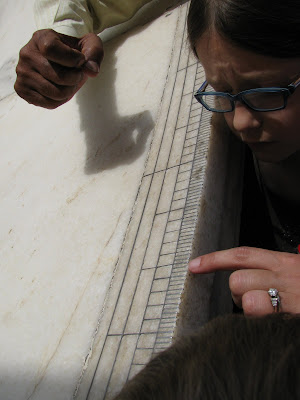
Come to find out that the elephant's "mahouts" had decided to take a chai break. The two drivers "parked" the animals on the street corner and walked to the neighborhood chaiwalla for some tea...


 We soak them for about 10-20 minutes in a product called, "Steriliq." It is a mild solution of essentially bleach and water. As the bottle says, it was originally designed to sterilize baby bottles but it works great on produce as well. Steriliq kills most of the surface bacteria. Then we rinse the veggies with filtered (RO) water and let them air-dry on the counter before we place them in the refrigerator.
We soak them for about 10-20 minutes in a product called, "Steriliq." It is a mild solution of essentially bleach and water. As the bottle says, it was originally designed to sterilize baby bottles but it works great on produce as well. Steriliq kills most of the surface bacteria. Then we rinse the veggies with filtered (RO) water and let them air-dry on the counter before we place them in the refrigerator. This time of year the produce dries in a very short time! And as you can see, the vegetables are very fresh and nice. The whole process probably takes about 45 minutes.
This time of year the produce dries in a very short time! And as you can see, the vegetables are very fresh and nice. The whole process probably takes about 45 minutes. My underwear was drying out on the front balcony railing for all 800 of my apartment complex neighbors to see. I suppose revenge is sweet...
My underwear was drying out on the front balcony railing for all 800 of my apartment complex neighbors to see. I suppose revenge is sweet...
 The sacred lake Pushkar is surrounded by many ghats - holy bathing places where ancient stone stairs meet the waters edge. The main beacon in Pushkar is the Brahma temple - the only one of its kind in India. Thousands of Hindus flock here each year for religious pilgrimage. As a result of this, many, many small temples have been built, in part for worship, and in part for revenue gotten from the many pilgrims who venture to this place.
The sacred lake Pushkar is surrounded by many ghats - holy bathing places where ancient stone stairs meet the waters edge. The main beacon in Pushkar is the Brahma temple - the only one of its kind in India. Thousands of Hindus flock here each year for religious pilgrimage. As a result of this, many, many small temples have been built, in part for worship, and in part for revenue gotten from the many pilgrims who venture to this place. I think our favorite sites in Pushkar were the short treks we took to the two other ancient temples in Pushkar. Both of these are situated on separarate small mountaintops overlooking the city. One is dedicated to Savitri & Gayatri (wives of Lord Brahma) and the other to Pap Mochini (above) - a rather obscure diety, but very old temple.
I think our favorite sites in Pushkar were the short treks we took to the two other ancient temples in Pushkar. Both of these are situated on separarate small mountaintops overlooking the city. One is dedicated to Savitri & Gayatri (wives of Lord Brahma) and the other to Pap Mochini (above) - a rather obscure diety, but very old temple.

 The Jai Prakash Yantra (above) was used in calculating celestial observations and tracking the signs of the zodiac. Jai created instruments for calculating the exact angle of the sun, positions of constellations (by calendar day and hour), and Calendar day. My favorite are his time pieces - two large sundials.
The Jai Prakash Yantra (above) was used in calculating celestial observations and tracking the signs of the zodiac. Jai created instruments for calculating the exact angle of the sun, positions of constellations (by calendar day and hour), and Calendar day. My favorite are his time pieces - two large sundials.  The smaller of the two, which is about 15 feet tall, is accurate to 20 seconds...
The smaller of the two, which is about 15 feet tall, is accurate to 20 seconds... The large sun dial is 27 meters tall. It can calculate the time to 2 seconds - and it is nearly 300 years old!
The large sun dial is 27 meters tall. It can calculate the time to 2 seconds - and it is nearly 300 years old! In Jaipur, we found the original "LassiWala". This shop has been in operation since 1944 and serves its lassis very fresh, very cold and very inexpensive - only 12 Rupees! (about 25 cents).
In Jaipur, we found the original "LassiWala". This shop has been in operation since 1944 and serves its lassis very fresh, very cold and very inexpensive - only 12 Rupees! (about 25 cents). 
 These lassis were so good, that we went on a lassi binge for the rest of our trip - ordering them wherever we went. By far, the Jaipur LassiWala served the best lassis that we ever had.
These lassis were so good, that we went on a lassi binge for the rest of our trip - ordering them wherever we went. By far, the Jaipur LassiWala served the best lassis that we ever had.